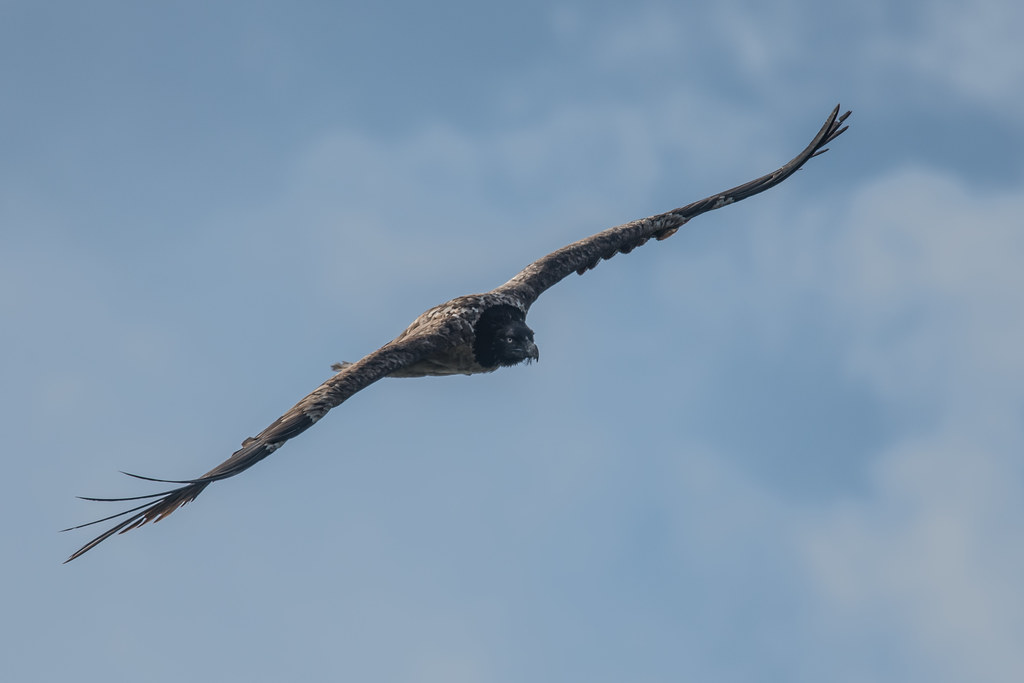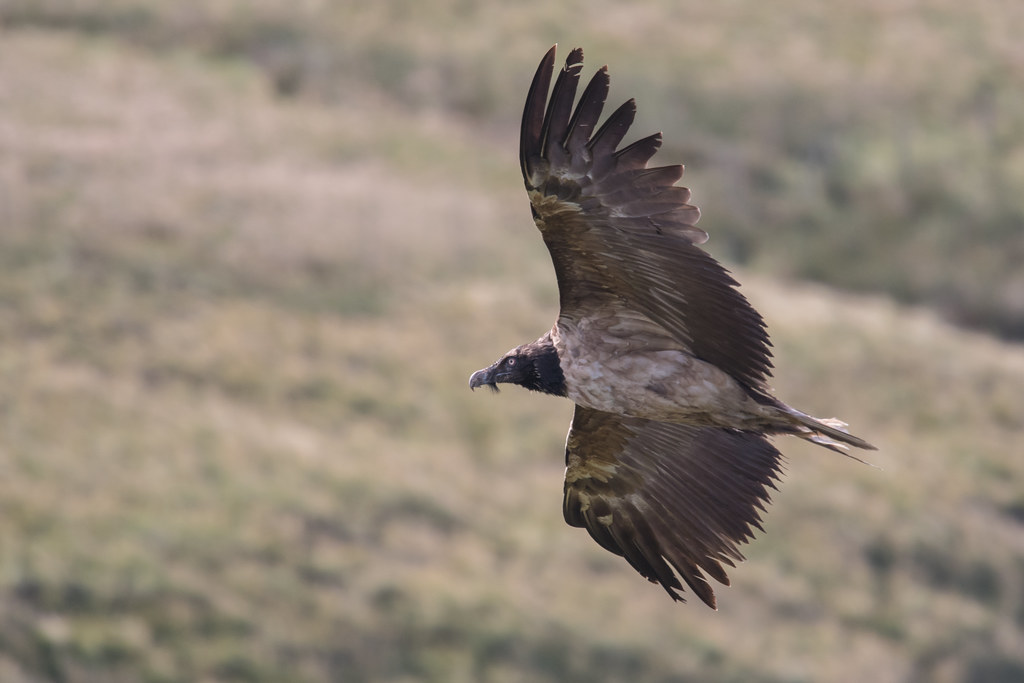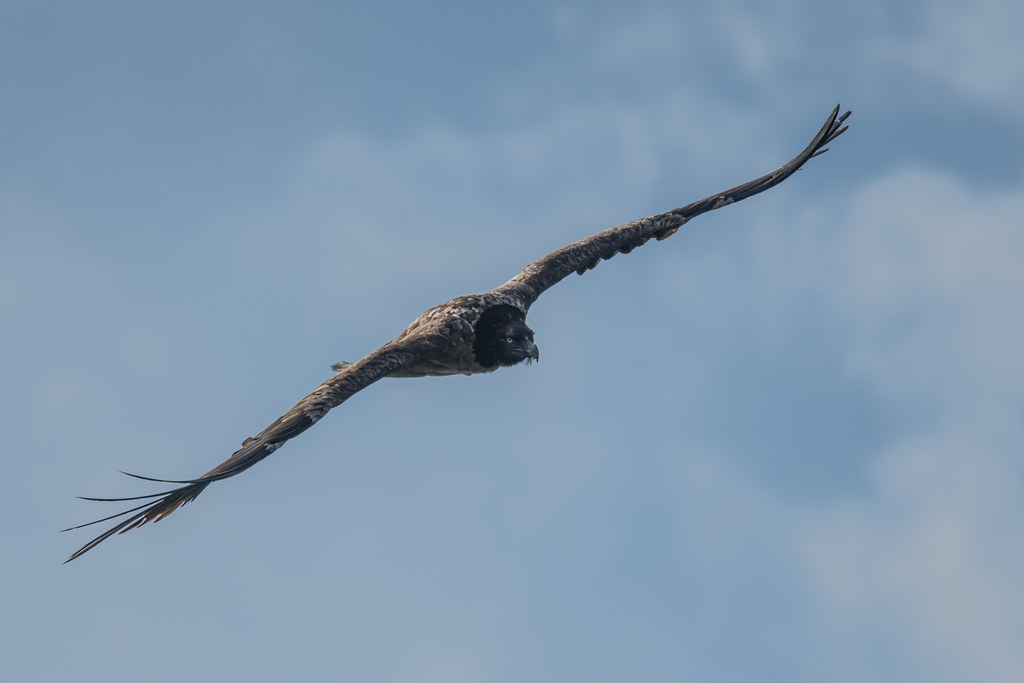
Tim writes: I gave up chasing rare birds some years ago but when a juvenile Lammergeier (aka Bearded Vulture) appeared in the Peak District, I decided it was too good to ignore. It was just a 20 minute drive from my house, plus an hour’s walk to reach its favourite roosting crag. Apparently this is a wild-bred bird that was seen in Belgium, Normandy then the Channel Islands during the last half of May. It was first seen in Britain on June 26th in Staffordshire. It then appeared in the Peak District but sightings were fleeting and sporadic but on 10 July it was found going to roost on cliffs in a remote valley called Abbey Brook.

Also known as the Bearded Vulture, the Lammergeier is the only animal on the planet known to feed almost exclusively on bones. It has an extremely acidic stomach (with a pH of around 1) that can dissolve bones and the high fat content marrow inside. Even the young nestlings are fed on small bones. Larger bones too big to swallow are dropped from a height onto rocks so that they break and it was this habit that led to yet another name of Ossifrage (bone breaker). The world population is low and declining, which has led to their IUCN classification as near-threatened. They are also massive, with a wingspan up to 2.8 metres. The main world distribution is in the Himalayas and Caucasus with small populations in the mountains of Europe. Which makes it really surprising that this immature bird should wander to Britain and end up in Yorkshire.

Mark writes: it’s almost enough to make one want to take up twitching…
But I’d prefer to see this as a symbol of rewilding – or indeed self-wilding. It’s amazing how quickly nature can return to the most unlikely areas if given the chance.
A vulture over the grouse moors – it almost looks like an omen.
This bird is further up the valley where the 2014 #sodden570 Hen Harrier Day was held. The Abbey Brook drains into the northern end of the Derwent Reservoir.
There have been Lammergeiers seen in the UK before – but they don’t ‘count’! By which I mean that this species has not been accepted on the official British List and this individual, though clearly the identification is not in question, might not ‘count’ either – see previous decisions and British List. Down the road from me, at Lilford Hall, the fourth Baron Lilford had a pair of free-flying Lammergeiers wandering around east Northamptonshire in the nineteenth century. So, it’s hardly worth a trip to South Yorkshire/Derbyshire.
[registration_form]
Regulars on this blog may recall a discussion about names. I may be mis-remembering but I think there was general agreement not to call the species lammergeier lest lamb breeders became overly worried. Wouldn’t want a ‘flying ant’ situation developing, the Farmer’s Weekly might go crazy.
Lamb breeders probably more worried about fly tippers than a Lammergeir.
Guess commenters on these blogs would not be happy if they got amalgamated all together with the fly tippers as part of general public.
They would then know how farmers in general feel as being assumed to all be shooters
Wildlife haters
Badger haters
Several types of bad farming
OMG the list could go on
A lot of the commenters need to wake up to the fact the odd individual is not representative of the majority.
Out of approximately one hundred local farmers probably three shoot and then only pheasants which in conservationists eyes are a nuisance anyway.
It’s also absolutely brilliant that it has turned up. A great sign of what nature can do. Like the tracked wolves that seem to roam around the ‘civilised’ parts of Europe.
This is one of those very special birds whether it makes it on to the official “British List” or not. If it is wild bred it probably should but then the last one should have too. If I still lived in North Yorkshire I would certainly go to visit it, from Wales almost certainly not. A great bird though.
Personally I think if it doesn’t have jesses it ought to be considered as a wild bird.
In the 19th century both Griffon and Egyptian Vultures reached County Cork and Essex respectively. It doesn’t seem consistent to get sniffy about this animal with White-tailed Eagles, Red Kites and Ospreys all pottering around the Midlands!
At one point last week, i could have seen it from our upstairs window
if i had been stood waiting, with my binoculars.
It’s a good addition to the list of birds that thrive on grouse moors.
Why shouldn’t it go on the list, there was also another one, a wild bird near Buckfastleigh in Devon a few years ago.
It showed up in bristol also
Re: British List / Rewilding
Don’t get your hopes up.
The links above say the population is not even self-sustaining in the Alps, and I wonder if it ever will be:
Could it be that this one was forced out of the Alps due to competition from its own or other vulture species?